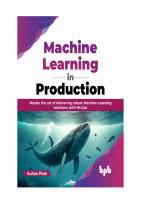The Machine Learning Solutions Architect Handbook: (Final),2nd Edition [2 ed.] 9781805122500
David Ping, Head of GenAI and ML Solution Architecture for global industries at AWS, provides expert insights and practi
140 7 20MB
English Pages 752 Year 2024
Table of contents :
Preface
Who this book is for
What this book covers
To get the most out of this book
Get in touch
Navigating the ML Lifecycle with ML Solutions Architecture
ML versus traditional software
ML lifecycle
Business problem understanding and ML problem framing
Data understanding and data preparation
Model training and evaluation
Model deployment
Model monitoring
Business metric tracking
ML challenges
ML solutions architecture
Business understanding and ML transformation
Identification and verification of ML techniques
System architecture design and implementation
ML platform workflow automation
Security and compliance
Summary
Exploring ML Business Use Cases
ML use cases in financial services
Capital market front office
Sales trading and research
Investment banking
Wealth management
Capital market back office operations
Net Asset Value review
Post-trade settlement failure prediction
Risk management and fraud
Anti-money laundering
Trade surveillance
Credit risk
Insurance
Insurance underwriting
Insurance claim management
ML use cases in media and entertainment
Content development and production
Content management and discovery
Content distribution and customer engagement
ML use cases in healthcare and life sciences
Medical imaging analysis
Drug discovery
Healthcare data management
ML use cases in manufacturing
Engineering and product design
Manufacturing operations – product quality and yield
Manufacturing operations – machine maintenance
ML use cases in retail
Product search and discovery
Targeted marketing
Sentiment analysis
Product demand forecasting
ML use cases in the automotive industry
Autonomous vehicles
Perception and localization
Decision and planning
Control
Advanced driver assistance systems (ADAS)
Summary
Exploring ML Algorithms
Technical requirements
How machines learn
Overview of ML algorithms
Consideration for choosing ML algorithms
Algorithms for classification and regression problems
Linear regression algorithms
Logistic regression algorithms
Decision tree algorithms
Random forest algorithm
Gradient boosting machine and XGBoost algorithms
K-nearest neighbor algorithm
Multi-layer perceptron (MLP) networks
Algorithms for clustering
Algorithms for time series analysis
ARIMA algorithm
DeepAR algorithm
Algorithms for recommendation
Collaborative filtering algorithm
Multi-armed bandit/contextual bandit algorithm
Algorithms for computer vision problems
Convolutional neural networks
ResNet
Algorithms for natural language processing (NLP) problems
Word2Vec
BERT
Generative AI algorithms
Generative adversarial network
Generative pre-trained transformer (GPT)
Large Language Model
Diffusion model
Hands-on exercise
Problem statement
Dataset description
Setting up a Jupyter Notebook environment
Running the exercise
Summary
Data Management for ML
Technical requirements
Data management considerations for ML
Data management architecture for ML
Data storage and management
AWS Lake Formation
Data ingestion
Kinesis Firehose
AWS Glue
AWS Lambda
Data cataloging
AWS Glue Data Catalog
Custom data catalog solution
Data processing
ML data versioning
S3 partitions
Versioned S3 buckets
Purpose-built data version tools
ML feature stores
Data serving for client consumption
Consumption via API
Consumption via data copy
Special databases for ML
Vector databases
Graph databases
Data pipelines
Authentication and authorization
Data governance
Data lineage
Other data governance measures
Hands-on exercise – data management for ML
Creating a data lake using Lake Formation
Creating a data ingestion pipeline
Creating a Glue Data Catalog
Discovering and querying data in the data lake
Creating an Amazon Glue ETL job to process data for ML
Building a data pipeline using Glue workflows
Summary
Exploring Open-Source ML Libraries
Technical requirements
Core features of open-source ML libraries
Understanding the scikit-learn ML library
Installing scikit-learn
Core components of scikit-learn
Understanding the Apache Spark ML library
Installing Spark ML
Core components of the Spark ML library
Understanding the TensorFlow deep learning library
Installing TensorFlow
Core components of TensorFlow
Hands-on exercise – training a TensorFlow model
Understanding the PyTorch deep learning library
Installing PyTorch
Core components of PyTorch
Hands-on exercise – building and training a PyTorch model
How to choose between TensorFlow and PyTorch
Summary
Kubernetes Container Orchestration Infrastructure Management
Technical requirements
Introduction to containers
Overview of Kubernetes and its core concepts
Namespaces
Pods
Deployment
Kubernetes Job
Kubernetes custom resources and operators
Services
Networking on Kubernetes
Security and access management
API authentication and authorization
Hands-on – creating a Kubernetes infrastructure on AWS
Problem statement
Lab instruction
Summary
Open-Source ML Platforms
Core components of an ML platform
Open-source technologies for building ML platforms
Implementing a data science environment
Building a model training environment
Registering models with a model registry
Serving models using model serving services
The Gunicorn and Flask inference engine
The TensorFlow Serving framework
The TorchServe serving framework
KFServing framework
Seldon Core
Triton Inference Server
Monitoring models in production
Managing ML features
Automating ML pipeline workflows
Apache Airflow
Kubeflow Pipelines
Designing an end-to-end ML platform
ML platform-based strategy
ML component-based strategy
Summary
Building a Data Science Environment Using AWS ML Services
Technical requirements
SageMaker overview
Data science environment architecture using SageMaker
Onboarding SageMaker users
Launching Studio applications
Preparing data
Preparing data interactively with SageMaker Data Wrangler
Preparing data at scale interactively
Processing data as separate jobs
Creating, storing, and sharing features
Training ML models
Tuning ML models
Deploying ML models for testing
Best practices for building a data science environment
Hands-on exercise – building a data science environment using AWS services
Problem statement
Dataset description
Lab instructions
Setting up SageMaker Studio
Launching a JupyterLab notebook
Training the BERT model in the Jupyter notebook
Training the BERT model with the SageMaker Training service
Deploying the model
Building ML models with SageMaker Canvas
Summary
Designing an Enterprise ML Architecture with AWS ML Services
Technical requirements
Key considerations for ML platforms
The personas of ML platforms and their requirements
ML platform builders
Platform users and operators
Common workflow of an ML initiative
Platform requirements for the different personas
Key requirements for an enterprise ML platform
Enterprise ML architecture pattern overview
Model training environment
Model training engine using SageMaker
Automation support
Model training lifecycle management
Model hosting environment
Inference engines
Authentication and security control
Monitoring and logging
Adopting MLOps for ML workflows
Components of the MLOps architecture
Monitoring and logging
Model training monitoring
Model endpoint monitoring
ML pipeline monitoring
Service provisioning management
Best practices in building and operating an ML platform
ML platform project execution best practices
ML platform design and implementation best practices
Platform use and operations best practices
Summary
Advanced ML Engineering
Technical requirements
Training large-scale models with distributed training
Distributed model training using data parallelism
Parameter server overview
AllReduce overview
Distributed model training using model parallelism
Naïve model parallelism overview
Tensor parallelism/tensor slicing overview
Implementing model-parallel training
Achieving low-latency model inference
How model inference works and opportunities for optimization
Hardware acceleration
Central processing units (CPUs)
Graphics processing units (GPUs)
Application-specific integrated circuit
Model optimization
Quantization
Pruning (also known as sparsity)
Graph and operator optimization
Graph optimization
Operator optimization
Model compilers
TensorFlow XLA
PyTorch Glow
Apache TVM
Amazon SageMaker Neo
Inference engine optimization
Inference batching
Enabling parallel serving sessions
Picking a communication protocol
Inference in large language models
Text Generation Inference (TGI)
DeepSpeed-Inference
FastTransformer
Hands-on lab – running distributed model training with PyTorch
Problem statement
Dataset description
Modifying the training script
Modifying and running the launcher notebook
Summary
Building ML Solutions with AWS AI Services
Technical requirements
What are AI services?
Overview of AWS AI services
Amazon Comprehend
Amazon Textract
Amazon Rekognition
Amazon Transcribe
Amazon Personalize
Amazon Lex V2
Amazon Kendra
Amazon Q
Evaluating AWS AI services for ML use cases
Building intelligent solutions with AI services
Automating loan document verification and data extraction
Loan document classification workflow
Loan data processing flow
Media processing and analysis workflow
E-commerce product recommendation
Customer self-service automation with intelligent search
Designing an MLOps architecture for AI services
AWS account setup strategy for AI services and MLOps
Code promotion across environments
Monitoring operational metrics for AI services
Hands-on lab – running ML tasks using AI services
Summary
AI Risk Management
Understanding AI risk scenarios
The regulatory landscape around AI risk management
Understanding AI risk management
Governance oversight principles
AI risk management framework
Applying risk management across the AI lifecycle
Business problem identification and definition
Data acquisition and management
Risk considerations
Risk mitigations
Experimentation and model development
Risk considerations
Risk mitigations
AI system deployment and operations
Risk considerations
Risk mitigations
Designing ML platforms with governance and risk management considerations
Data and model documentation
Lineage and reproducibility
Observability and auditing
Scalability and performance
Data quality
Summary
Bias, Explainability, Privacy, and Adversarial Attacks
Understanding bias
Understanding ML explainability
LIME
SHAP
Understanding security and privacy-preserving ML
Differential privacy
Understanding adversarial attacks
Evasion attacks
PGD attacks
HopSkipJump attacks
Data poisoning attacks
Clean-label backdoor attack
Model extraction attack
Attacks against generative AI models
Defense against adversarial attacks
Robustness-based methods
Detector-based method
Open-source tools for adversarial attacks and defenses
Hands-on lab – detecting bias, explaining models, training privacy-preserving mode, and simulating adversarial attack
Problem statement
Detecting bias in the training dataset
Explaining feature importance for a trained model
Training privacy-preserving models
Simulate a clean-label backdoor attack
Summary
Charting the Course of Your ML Journey
ML adoption stages
Exploring AI/ML
Disjointed AI/ML
Integrated AI/ML
Advanced AI/ML
AI/ML maturity and assessment
Technical maturity
Business maturity
Governance maturity
Organization and talent maturity
Maturity assessment and improvement process
AI/ML operating models
Centralized model
Decentralized model
Hub and spoke model
Solving ML journey challenges
Developing the AI vision and strategy
Getting started with the first AI/ML initiative
Solving scaling challenges with AI/ML adoption
Solving ML use case scaling challenges
Solving technology scaling challenges
Solving governance scaling challenges
Summary
Navigating the Generative AI Project Lifecycle
The advancement and economic impact of generative AI
What industries are doing with generative AI
Financial services
Healthcare and life sciences
Media and entertainment
Automotive and manufacturing
The lifecycle of a generative AI project and the core technologies
Business use case selection
FM selection and evaluation
Initial screening via manual assessment
Automated model evaluation
Human evaluation
Assessing AI risks for FMs
Other evaluation consideration
Building FMs from scratch via pre-training
Adaptation and customization
Domain adaptation pre-training
Fine-tuning
Reinforcement learning from human feedback
Prompt engineering
Model management and deployment
The limitations, risks, and challenges of adopting generative AI
Summary
Designing Generative AI Platforms and Solutions
Operational considerations for generative AI platforms and solutions
New generative AI workflow and processes
New technology components
New roles
Exploring generative AI platforms
The prompt management component
FM benchmark workbench
Supervised fine-tuning and RLHF
FM monitoring
The retrieval-augmented generation pattern
Open-source frameworks for RAG
LangChain
LlamaIndex
Evaluating a RAG pipeline
Advanced RAG patterns
Designing a RAG architecture on AWS
Choosing an LLM adaptation method
Response quality
Cost of the adaptation
Implementation complexity
Bringing it all together
Considerations for deploying generative AI applications in production
Model readiness
Decision-making workflow
Responsible AI assessment
Guardrails in production environments
External knowledge change management
Practical generative AI business solutions
Generative AI-powered semantic search engine
Financial data analysis and research workflow
Clinical trial recruiting workflow
Media entertainment content creation workflow
Car design workflow
Contact center customer service operation
Are we close to having artificial general intelligence?
The symbolic approach
The connectionist/neural network approach
The neural-symbolic approach
Summary
Other Books You May Enjoy
Index
Preface
Who this book is for
What this book covers
To get the most out of this book
Get in touch
Navigating the ML Lifecycle with ML Solutions Architecture
ML versus traditional software
ML lifecycle
Business problem understanding and ML problem framing
Data understanding and data preparation
Model training and evaluation
Model deployment
Model monitoring
Business metric tracking
ML challenges
ML solutions architecture
Business understanding and ML transformation
Identification and verification of ML techniques
System architecture design and implementation
ML platform workflow automation
Security and compliance
Summary
Exploring ML Business Use Cases
ML use cases in financial services
Capital market front office
Sales trading and research
Investment banking
Wealth management
Capital market back office operations
Net Asset Value review
Post-trade settlement failure prediction
Risk management and fraud
Anti-money laundering
Trade surveillance
Credit risk
Insurance
Insurance underwriting
Insurance claim management
ML use cases in media and entertainment
Content development and production
Content management and discovery
Content distribution and customer engagement
ML use cases in healthcare and life sciences
Medical imaging analysis
Drug discovery
Healthcare data management
ML use cases in manufacturing
Engineering and product design
Manufacturing operations – product quality and yield
Manufacturing operations – machine maintenance
ML use cases in retail
Product search and discovery
Targeted marketing
Sentiment analysis
Product demand forecasting
ML use cases in the automotive industry
Autonomous vehicles
Perception and localization
Decision and planning
Control
Advanced driver assistance systems (ADAS)
Summary
Exploring ML Algorithms
Technical requirements
How machines learn
Overview of ML algorithms
Consideration for choosing ML algorithms
Algorithms for classification and regression problems
Linear regression algorithms
Logistic regression algorithms
Decision tree algorithms
Random forest algorithm
Gradient boosting machine and XGBoost algorithms
K-nearest neighbor algorithm
Multi-layer perceptron (MLP) networks
Algorithms for clustering
Algorithms for time series analysis
ARIMA algorithm
DeepAR algorithm
Algorithms for recommendation
Collaborative filtering algorithm
Multi-armed bandit/contextual bandit algorithm
Algorithms for computer vision problems
Convolutional neural networks
ResNet
Algorithms for natural language processing (NLP) problems
Word2Vec
BERT
Generative AI algorithms
Generative adversarial network
Generative pre-trained transformer (GPT)
Large Language Model
Diffusion model
Hands-on exercise
Problem statement
Dataset description
Setting up a Jupyter Notebook environment
Running the exercise
Summary
Data Management for ML
Technical requirements
Data management considerations for ML
Data management architecture for ML
Data storage and management
AWS Lake Formation
Data ingestion
Kinesis Firehose
AWS Glue
AWS Lambda
Data cataloging
AWS Glue Data Catalog
Custom data catalog solution
Data processing
ML data versioning
S3 partitions
Versioned S3 buckets
Purpose-built data version tools
ML feature stores
Data serving for client consumption
Consumption via API
Consumption via data copy
Special databases for ML
Vector databases
Graph databases
Data pipelines
Authentication and authorization
Data governance
Data lineage
Other data governance measures
Hands-on exercise – data management for ML
Creating a data lake using Lake Formation
Creating a data ingestion pipeline
Creating a Glue Data Catalog
Discovering and querying data in the data lake
Creating an Amazon Glue ETL job to process data for ML
Building a data pipeline using Glue workflows
Summary
Exploring Open-Source ML Libraries
Technical requirements
Core features of open-source ML libraries
Understanding the scikit-learn ML library
Installing scikit-learn
Core components of scikit-learn
Understanding the Apache Spark ML library
Installing Spark ML
Core components of the Spark ML library
Understanding the TensorFlow deep learning library
Installing TensorFlow
Core components of TensorFlow
Hands-on exercise – training a TensorFlow model
Understanding the PyTorch deep learning library
Installing PyTorch
Core components of PyTorch
Hands-on exercise – building and training a PyTorch model
How to choose between TensorFlow and PyTorch
Summary
Kubernetes Container Orchestration Infrastructure Management
Technical requirements
Introduction to containers
Overview of Kubernetes and its core concepts
Namespaces
Pods
Deployment
Kubernetes Job
Kubernetes custom resources and operators
Services
Networking on Kubernetes
Security and access management
API authentication and authorization
Hands-on – creating a Kubernetes infrastructure on AWS
Problem statement
Lab instruction
Summary
Open-Source ML Platforms
Core components of an ML platform
Open-source technologies for building ML platforms
Implementing a data science environment
Building a model training environment
Registering models with a model registry
Serving models using model serving services
The Gunicorn and Flask inference engine
The TensorFlow Serving framework
The TorchServe serving framework
KFServing framework
Seldon Core
Triton Inference Server
Monitoring models in production
Managing ML features
Automating ML pipeline workflows
Apache Airflow
Kubeflow Pipelines
Designing an end-to-end ML platform
ML platform-based strategy
ML component-based strategy
Summary
Building a Data Science Environment Using AWS ML Services
Technical requirements
SageMaker overview
Data science environment architecture using SageMaker
Onboarding SageMaker users
Launching Studio applications
Preparing data
Preparing data interactively with SageMaker Data Wrangler
Preparing data at scale interactively
Processing data as separate jobs
Creating, storing, and sharing features
Training ML models
Tuning ML models
Deploying ML models for testing
Best practices for building a data science environment
Hands-on exercise – building a data science environment using AWS services
Problem statement
Dataset description
Lab instructions
Setting up SageMaker Studio
Launching a JupyterLab notebook
Training the BERT model in the Jupyter notebook
Training the BERT model with the SageMaker Training service
Deploying the model
Building ML models with SageMaker Canvas
Summary
Designing an Enterprise ML Architecture with AWS ML Services
Technical requirements
Key considerations for ML platforms
The personas of ML platforms and their requirements
ML platform builders
Platform users and operators
Common workflow of an ML initiative
Platform requirements for the different personas
Key requirements for an enterprise ML platform
Enterprise ML architecture pattern overview
Model training environment
Model training engine using SageMaker
Automation support
Model training lifecycle management
Model hosting environment
Inference engines
Authentication and security control
Monitoring and logging
Adopting MLOps for ML workflows
Components of the MLOps architecture
Monitoring and logging
Model training monitoring
Model endpoint monitoring
ML pipeline monitoring
Service provisioning management
Best practices in building and operating an ML platform
ML platform project execution best practices
ML platform design and implementation best practices
Platform use and operations best practices
Summary
Advanced ML Engineering
Technical requirements
Training large-scale models with distributed training
Distributed model training using data parallelism
Parameter server overview
AllReduce overview
Distributed model training using model parallelism
Naïve model parallelism overview
Tensor parallelism/tensor slicing overview
Implementing model-parallel training
Achieving low-latency model inference
How model inference works and opportunities for optimization
Hardware acceleration
Central processing units (CPUs)
Graphics processing units (GPUs)
Application-specific integrated circuit
Model optimization
Quantization
Pruning (also known as sparsity)
Graph and operator optimization
Graph optimization
Operator optimization
Model compilers
TensorFlow XLA
PyTorch Glow
Apache TVM
Amazon SageMaker Neo
Inference engine optimization
Inference batching
Enabling parallel serving sessions
Picking a communication protocol
Inference in large language models
Text Generation Inference (TGI)
DeepSpeed-Inference
FastTransformer
Hands-on lab – running distributed model training with PyTorch
Problem statement
Dataset description
Modifying the training script
Modifying and running the launcher notebook
Summary
Building ML Solutions with AWS AI Services
Technical requirements
What are AI services?
Overview of AWS AI services
Amazon Comprehend
Amazon Textract
Amazon Rekognition
Amazon Transcribe
Amazon Personalize
Amazon Lex V2
Amazon Kendra
Amazon Q
Evaluating AWS AI services for ML use cases
Building intelligent solutions with AI services
Automating loan document verification and data extraction
Loan document classification workflow
Loan data processing flow
Media processing and analysis workflow
E-commerce product recommendation
Customer self-service automation with intelligent search
Designing an MLOps architecture for AI services
AWS account setup strategy for AI services and MLOps
Code promotion across environments
Monitoring operational metrics for AI services
Hands-on lab – running ML tasks using AI services
Summary
AI Risk Management
Understanding AI risk scenarios
The regulatory landscape around AI risk management
Understanding AI risk management
Governance oversight principles
AI risk management framework
Applying risk management across the AI lifecycle
Business problem identification and definition
Data acquisition and management
Risk considerations
Risk mitigations
Experimentation and model development
Risk considerations
Risk mitigations
AI system deployment and operations
Risk considerations
Risk mitigations
Designing ML platforms with governance and risk management considerations
Data and model documentation
Lineage and reproducibility
Observability and auditing
Scalability and performance
Data quality
Summary
Bias, Explainability, Privacy, and Adversarial Attacks
Understanding bias
Understanding ML explainability
LIME
SHAP
Understanding security and privacy-preserving ML
Differential privacy
Understanding adversarial attacks
Evasion attacks
PGD attacks
HopSkipJump attacks
Data poisoning attacks
Clean-label backdoor attack
Model extraction attack
Attacks against generative AI models
Defense against adversarial attacks
Robustness-based methods
Detector-based method
Open-source tools for adversarial attacks and defenses
Hands-on lab – detecting bias, explaining models, training privacy-preserving mode, and simulating adversarial attack
Problem statement
Detecting bias in the training dataset
Explaining feature importance for a trained model
Training privacy-preserving models
Simulate a clean-label backdoor attack
Summary
Charting the Course of Your ML Journey
ML adoption stages
Exploring AI/ML
Disjointed AI/ML
Integrated AI/ML
Advanced AI/ML
AI/ML maturity and assessment
Technical maturity
Business maturity
Governance maturity
Organization and talent maturity
Maturity assessment and improvement process
AI/ML operating models
Centralized model
Decentralized model
Hub and spoke model
Solving ML journey challenges
Developing the AI vision and strategy
Getting started with the first AI/ML initiative
Solving scaling challenges with AI/ML adoption
Solving ML use case scaling challenges
Solving technology scaling challenges
Solving governance scaling challenges
Summary
Navigating the Generative AI Project Lifecycle
The advancement and economic impact of generative AI
What industries are doing with generative AI
Financial services
Healthcare and life sciences
Media and entertainment
Automotive and manufacturing
The lifecycle of a generative AI project and the core technologies
Business use case selection
FM selection and evaluation
Initial screening via manual assessment
Automated model evaluation
Human evaluation
Assessing AI risks for FMs
Other evaluation consideration
Building FMs from scratch via pre-training
Adaptation and customization
Domain adaptation pre-training
Fine-tuning
Reinforcement learning from human feedback
Prompt engineering
Model management and deployment
The limitations, risks, and challenges of adopting generative AI
Summary
Designing Generative AI Platforms and Solutions
Operational considerations for generative AI platforms and solutions
New generative AI workflow and processes
New technology components
New roles
Exploring generative AI platforms
The prompt management component
FM benchmark workbench
Supervised fine-tuning and RLHF
FM monitoring
The retrieval-augmented generation pattern
Open-source frameworks for RAG
LangChain
LlamaIndex
Evaluating a RAG pipeline
Advanced RAG patterns
Designing a RAG architecture on AWS
Choosing an LLM adaptation method
Response quality
Cost of the adaptation
Implementation complexity
Bringing it all together
Considerations for deploying generative AI applications in production
Model readiness
Decision-making workflow
Responsible AI assessment
Guardrails in production environments
External knowledge change management
Practical generative AI business solutions
Generative AI-powered semantic search engine
Financial data analysis and research workflow
Clinical trial recruiting workflow
Media entertainment content creation workflow
Car design workflow
Contact center customer service operation
Are we close to having artificial general intelligence?
The symbolic approach
The connectionist/neural network approach
The neural-symbolic approach
Summary
Other Books You May Enjoy
Index
![The Machine Learning Solutions Architect Handbook: (Final),2nd Edition [2 ed.]
9781805122500](https://ebin.pub/img/200x200/the-machine-learning-solutions-architect-handbook-final2nd-edition-2nbsped-9781805122500.jpg)
- Author / Uploaded
- David Ping
- Similar Topics
- Computers
- Algorithms and Data Structures: Pattern Recognition









